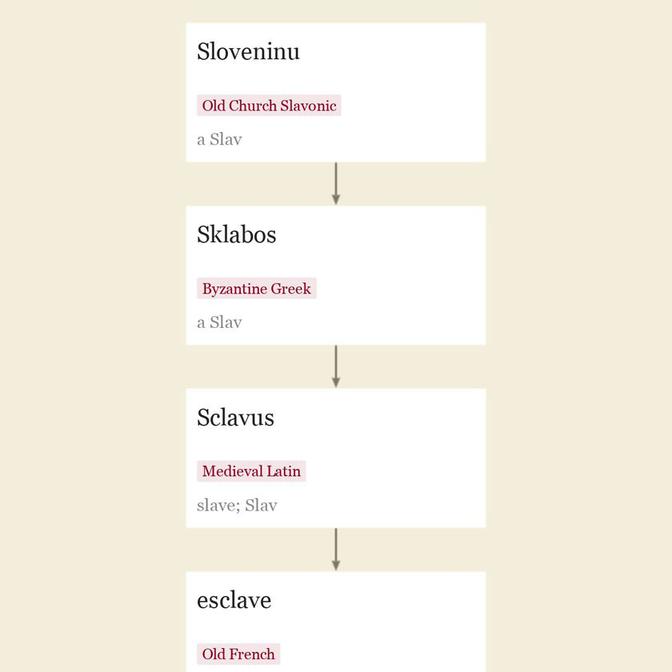slavocracy (n.)
也称 slaveocracy,指美国历史上“奴隶主集体”,尤其是指“奴隶主及其利益的政治支配”,特别是关于维护奴隶制度的方面,该词于1840年不规则地由 slave(名词)和 -cracy “统治或治理”组成。相关词汇: Slavocrat。
slavocracy 的相关词汇
这个词缀用于构成名词,表示“由……统治或管理”,源自法语 -cratie 或直接源自中世纪拉丁语 -cratia,来自希腊语 -kratia,意为“权力,力量; 统治,支配; 掌权,权威”,源自 kratos,意为“力量”,源自 PIE 语言家族的 *kre-tes-,意为“权力,力量”,是词根 *kar- 的带后缀形式,意为“坚硬的”。连接词缀 -o- 被视为其中的一部分。该词缀在英语中自1800年以来一直是生产性的。

公元1300年, sclave, esclave,“被他人视为财产或奴隶的人”,源自于古法语 esclave(13世纪)和直接源自于中世纪拉丁语 Sclavus “奴隶”(也是意大利语 schiavo,法语 esclave,西班牙语 esclavo 的来源),最初是指“斯拉夫人”(见 Slav); 在这个次要意义上使用,是因为许多斯拉夫人被征服的民族出售为奴隶。
The oldest written history of the Slavs can be shortly summarised--myriads of slave hunts and the enthralment of entire peoples. The Slav was the most prized of human goods. With increased strength outside his marshy land of origin, hardened to the utmost against all privation, industrious, content with little, good-humoured, and cheerful, he filled the slave markets of Europe, Asia, and Africa. It must be remembered that for every Slavonic slave who reached his destination, at least ten succumbed to inhuman treatment during transport and to the heat of the climate. Indeed Ibrāhīm (tenth century), himself in all probability a slave dealer, says: "And the Slavs cannot travel to Lombardy on account of the heat which is fatal to them." Hence their high price.
The Arabian geographer of the ninth century tells us how the Magyars in the Pontus steppe dominated all the Slavs dwelling near them. The Magyars made raids upon the Slavs and took their prisoners along the coast to Kerkh where the Byzantines came to meet them and gave Greek brocades and such wares in exchange for the prisoners. ["The Cambridge Medieval History," Vol. II, 1913]
斯拉夫人最古老的书面历史可以简要概括为——无数的奴隶狩猎和整个民族的奴役。斯拉夫人是最珍贵的人类商品。随着他在起源地以外的强大力量,对所有的剥夺都变得极为坚韧,勤劳,满足于少量,好脾气和开朗,他填满了欧洲,亚洲和非洲的奴隶市场。必须记住,对于每个到达目的地的斯拉夫奴隶,至少有十个在运输过程中死于不人道的待遇和气候的炎热。事实上,伊布拉欣(十世纪),他本人很可能是一个奴隶贩子,说:“斯拉夫人由于致命的炎热无法前往伦巴第。”因此他们的价格很高。
九世纪的阿拉伯地理学家告诉我们,匈牙利人在波斯草原上统治着他们附近的所有斯拉夫人。匈牙利人袭击斯拉夫人,将他们的俘虏沿海岸带到克尔克,拜占庭人来迎接他们,并用希腊锦缎和其他物品交换俘虏。[“剑桥中世纪史”,第二卷,1913年]
“失去对某种习惯或恶习的抵抗力的人”的意思始于1550年代。从1904年开始应用于设备,特别是那些由他人控制的设备(比较航海中的 slave jib,以及火车头,闪光灯,放大器等)。在美国历史上, slave state 是指国内奴隶制盛行的州,始于1812年。
It is absurd to bring back a runaway slave. If a slave can survive without a master, is it not awful to admit that the master cannot live without the slave? [Diogenes, fragment 6, transl. Guy Davenport]
抓回逃跑的奴隶是荒谬的。如果一个奴隶可以在没有主人的情况下生存,难道主人不能没有奴隶而生存吗?[戴奥吉尼斯,第6片段,翻译盖伊·达文波特]
古英语 Wealh “不列颠人”也开始在公元850年左右被用于“农奴,奴隶”的意义上; 梵语 dasa- 可以表示“奴隶”,显然与 dasyu- “印度的史前居民”有关。格罗斯的词典(1785年)在 Negroe 下有“黑人; 比喻为奴隶”的定义,而不考虑种族。古英语中更常见的奴隶词汇是 þeow(与 þeowian “服务”有关)和 þræl(见 thrall)。斯拉夫语中“奴隶”(俄语 rab,塞尔维亚-克罗地亚语 rob,古教会斯拉夫语 rabu)源自古斯拉夫语 *orbu,源自于 PIE 词根 *orbh-(也是 orphan(n.)的来源),其基本意义似乎是“改变归属的东西”(在奴隶的情况下,从自我到主人)。斯拉夫语单词也是 robot 的来源。
scl- 缩减为 sl- 在英语中是正常的(比较石板,荷兰语 slaaf,丹麦语 slave,但德语 Sklave)。